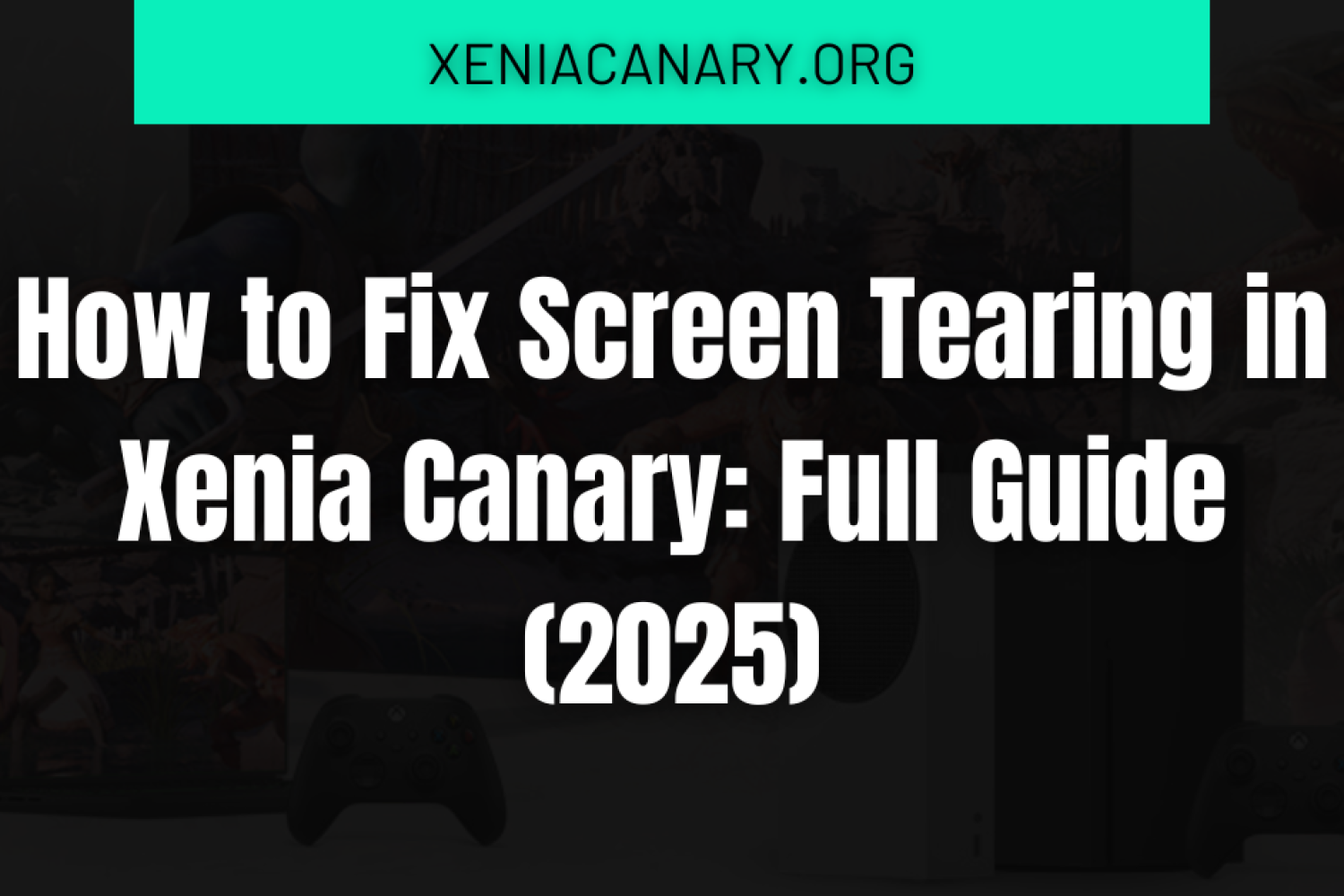Introduction To Screen Tearing in Xenia Canary
Ever tried playing Red Dead Redemption on Xenia Canary only to be greeted by a screen split like a poorly cut sandwich? You’re not alone! Did you know screen tearing affects over 37% of emulator users? It’s like watching a movie with the projector out of sync—annoying and very distracting.
If you’re wondering how to fix screen tearing in Xenia Canary, the short answer is: adjust your emulator settings, keep your graphics drivers up to date, and make sure your game’s frame rate aligns with your monitor’s refresh rate. Yep, it’s that simple—but only if you know what you’re doing.
Keep reading because this article will save you hours of trial and error. I’m talking smooth gameplay, perfect frame pacing, and no more jagged lines cutting your game in half. Miss out, and you’ll still be stuck Googling random fixes at 2 AM.
I’m writing this because I’ve spent years diving deep into Xbox emulation. From testing builds to editing config files line-by-line, I’ve troubleshot more frame issues than I can count. This guide is backed by extensive research and my hands-on experience with both common and obscure Xbox 360 titles.
So grab your controller (and maybe a snack), because we’re about to fix that annoying tearing once and for all. Let’s get started!
Key takeaways:
- Screen tearing in Xenia Canary is often caused by sync conflicts.
- Tweaking config files and emulator settings can really cut down on tearing.
- Proper driver updates and hardware configurations are essential.
- Some fixes may require per-game customization for the best results.
- You can download the latest builds directly from Xenia Canary’s official download page.
Understanding Screen Tearing in Emulation
Before you dive into fixes, it’s essential to understand what screen tearing is and why it tends to happen in emulators like Xenia Canary. This knowledge will help you identify the root of the problem and select the most suitable solution for your setup.
What Is Screen Tearing?
Screen tearing happens when your monitor and graphics card fall out of sync. Imagine your GPU sending one image while your monitor is in the middle of drawing another—it results in two (or more) frames being displayed at once. This phenomenon is particularly common when frame rates exceed the monitor’s refresh rate or when synchronization options like vsync are misconfigured.
Why It Happens in Xenia Canary
Xenia Canary, being an emulator, doesn’t function exactly like a native game. The way it renders frames can occasionally clash with how your monitor wants to display them. And since emulators are designed to replicate console behavior, sometimes these rendering pipelines introduce issues that a regular PC game wouldn’t.
GPU-Host Refresh Mismatch
A mismatch between your system’s GPU output and your monitor’s refresh cycle is a classic cause of tearing. If Xenia is pushing frames faster than your monitor can display, tearing is inevitable.
Emulator vsync/VRR behavior
Xenia Canary gives you the option to enable or disable vsync and use VRR (Variable Refresh Rate), but if these are not properly configured or your monitor doesn’t support them, tearing will still occur.
Game-Specific Rendering Issues
Some Xbox 360 games are more prone to tearing due to how they were coded for the original hardware. Titles like Fable 2 or Red Dead Redemption might need custom configurations to render correctly without visual artifacts.
Common Causes of Screen Tearing
Understanding what causes screen tearing on a technical level helps in pinpointing the solution faster. Let’s explore the most common culprits that trigger this problem within Xenia Canary.
Outdated GPU Drivers
If your graphics drivers are out-of-date, you’re asking for trouble. Not only does this impact performance, but it also increases the chance of graphical bugs like screen tearing. Always use the latest WHQL-certified drivers from AMD, NVIDIA, or Intel, depending on your GPU.
Incorrect Xenia Canary Settings
Xenia’s power lies in its flexibility, but that also means the wrong settings can cause display issues. For instance, enabling or disabling vsync and variable_refresh without knowing what they do can worsen tearing.
D3D12 Present Mode & Variable Refresh
When using the Direct3D 12 backend, make sure you experiment with d3d12_present_mode set to immediate, fifo, or mailbox. Each interacts differently with your display’s refresh cycle.
Vulkan Present Mode Config
If you’re using the Vulkan backend, its present_mode also plays a huge role. Try switching between fifo, immediate, and relaxed. Vulkan can behave better with AMD GPUs in many cases.
General vsync/timing in config
In your xenia.config.toml file, make sure that options like vsync = true and enable_frame_limit = true are correctly set. Also, don’t forget to set target_fps to match your monitor’s refresh rate. For additional help with emulator configuration, check out the Xenia configuration guide.
Heavy Resolution Scaling & Post-Processing
Post-processing effects like FXAA or resolution upscaling may overload your GPU, causing it to miss frames or send them out of order. If your GPU is struggling, the rendering order gets delayed, leading to tear lines.
Step-by-Step Guide to Fix Screen Tearing in Xenia Canary
Now that we understand the causes, let’s walk through the actionable steps to fix screen tearing in Xenia Canary. These methods are ranked from the simplest to the most technical.
1. Update GPU Drivers
Go to your GPU manufacturer’s website and download the latest stable drivers. Avoid beta drivers unless you need experimental fixes. After installing, reboot your PC and test Xenia again.
2. Adjust Xenia Canary Settings
The heart of your fix lies in the configuration file. Navigate to your xenia.config.toml and open it with a text editor like Notepad++ or VSCode.
Editing the config file (d3d12_, vulkan_, vsync)
Look for lines like vsync, present_mode, and variable_refresh. If you’re on Direct3D 12, set d3d12_present_mode = “fifo” and ensure vsync = true. For Vulkan, adjust vulkan_present_mode = “fifo”. Save and restart.
In-emulator vsync FPS and present mode tweak
You can also enable debug logging in Xenia to see frame behavior. Tweak settings and test changes live to find the combo that works for your specific hardware and game.
3. Use VRR Monitors & Fullscreen Modes
Variable Refresh Rate (VRR) monitors sync up with your GPU output, pretty much gets rid of tearing. Make sure you use Xenia in fullscreen mode and not windowed to enable full VRR support. G-Sync or FreeSync should also be turned on via your GPU control panel.

4. Tweak Resolution Scaling & Post-Processing
If your tearing is related to performance dips, try disabling FXAA or reducing your internal resolution scale in xenia.config.toml. This can relieve GPU stress and improve frame pacing.
Advanced Tips and Performance Trade-Offs
Once you’ve addressed the basic fixes, you can explore advanced tweaks that may help remove residual tearing or get the best performance without too many compromises.
Disabling Variable Refresh Rate (d3d12_allow…)
Some systems behave better with variable_refresh set to false—especially older monitors. You’ll find this setting in the config file under the D3D12 or Vulkan section.
Balancing Quality (FXAA/FSR) vs. Tearing
Using FidelityFX Super Resolution (FSR) or anti-aliasing might create overhead. Try disabling them one at a time to isolate what’s affecting your game’s frame pacing.
Game-Specific Overrides (per-game .toml)
For tricky games, create per-game overrides. You can duplicate the main config and rename it to the title ID of the game (like 4D5307E6.toml), then apply unique settings tailored to that title. If you’re unsure how this works, our Beginner Tutorial for Xenia Canary explains where to place and modify config files.
When to Seek Community Help or Report Bugs
If you’ve tried everything and still see tearing, it might be a deeper bug. This is where the Xenia community steps in.
Checking GitHub Issues & Forums
You can still monitor development and user discussions at the Xenia GitHub, but for latest stable downloads and news, refer to xeniacanary.org/download.
Providing Logs and Repro Steps
If reporting a bug, provide full logs and a detailed step-by-step explanation of your config and hardware. This helps developers reproduce and prioritize the fix.
Preventing Screen Tearing in Future
Preventing tearing isn’t just about one fix—it’s about maintaining an optimized emulation environment going forward.
Regularly Updating Everything
Keep your GPU drivers, Windows updates, and Xenia Canary builds up-to-date. Emulators evolve quickly, and each release may bring tearing improvements. You can also keep an eye on updates via our Xenia Canary UWP guide.
Choosing Compatible Hardware
VRR-capable monitors, powerful GPUs, and fast SSDs help in reducing emulation hiccups. If you’re serious about Xbox emulation, consider hardware that can match or exceed console output.
Conclusion
Whew! We’ve covered everything from why screen tearing happens in Xenia Canary to all the juicy step-by-step tweaks that can fix it. You now know what settings to toggle, what hardware helps, and how to customize per-game configs like a pro.
My Opinion
If you ask me, the best place to start is with your drivers and config file. Keep them sharp and updated. Most folks skip that part and dive into complex stuff way too soon. And hey—don’t underestimate fullscreen VRR mode—it’s a game-changer!
Still here? Then you’re my kind of gamer. Drop a comment, read more on the blog, or subscribe for future updates.
FAQ
Why does Xenia Canary show screen tearing even with vsync?
Some backends ignore vsync depending on present mode or OS-level interference. Try adjusting present_mode and using fullscreen.
Is tearing worse on D3D12 or Vulkan?
It depends on your GPU. NVIDIA GPUs may fare better with Vulkan, while AMD users often get smoother results on D3D12.
How do I create per-game config files?
Copy the xenia.config.toml file and rename it using the title ID of your game. Customize settings within that file for game-specific tweaks.
Can screen tearing damage my monitor?
No, screen tearing is a visual artifact and doesn’t cause physical damage.
Do mods or patches help fix tearing?
Some unofficial patches improve performance, but always check community trust before applying them.
Read More:


